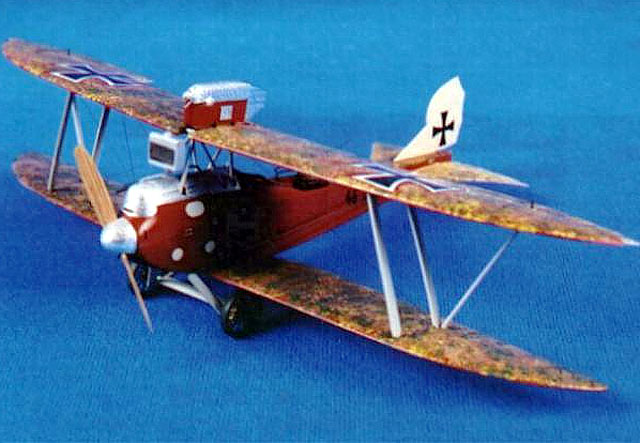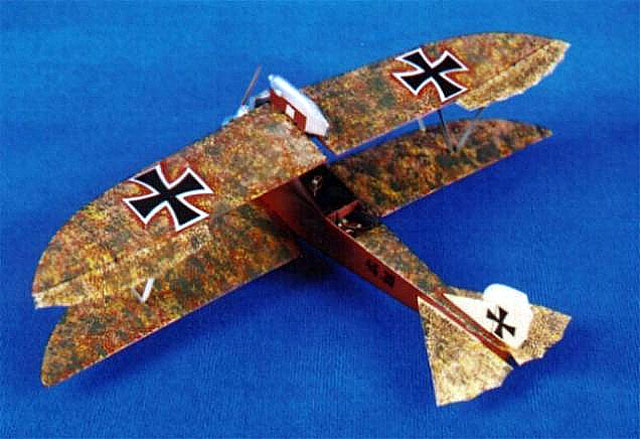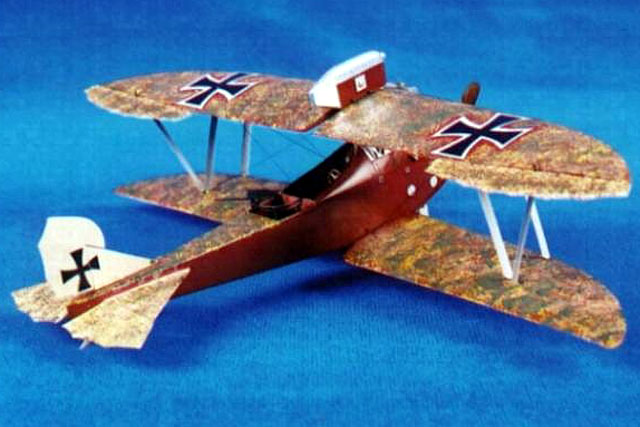|
Lloyd C.V 46.30, Flik 53/D
Scratchbuilt in 1/48
Scale
by
Michael Robinson
|

|
|
Lloyd C.V 46.30, Flik
53/D |

HyperScale is proudly supported by
Squadron.com
The Lloyd CV was an Austro-Hungarian design that
flew in the later part of the War. This particular model represents a
machine delivered in September 1917, with the Autumn Leaf mottle
camouflage applied to the upper surfaces by sequentially splotching the
surface with paint saturated sponges or rags. Starting over the base
mahogany plywood, Mustard Yellow, then Terra Cotta and then finally
Medium Green were applied in that order to achieve the desired effect.
In a departure from most Austro-Hungarian aircraft
of the war, the wing crosses have a white outline applied to them to
help them stand out against the dark, highly varnished and polished
mahogany plywood that the airplane was constructed from, rather than
just a simple black cross, as was the norm. The entire airframe was
constructed of mahogany plywood, the only fabric surfaces being the
control surfaces, the fin and horizontal stabilizer.

Lloyd CV’s were one of the faster aircraft of the war, with a top speed
of about 125 miles per hour. Unfortunately they also had a very high
landing and stall speed, which more often than not resulted in noseovers
and landing accidents. They were armed with a single Type II VK Gun
Canister on the top wing and a single Schwarzlose 8 mm machine gun
mounted on a ring for the Observer.
Fuselage
The fuselage is vacuum-formed .040 styrene done
over a carved wooden master. Interior details were added from bits and
pieces of sprue, wire, and scavenging from the parts bin. The instrument
panel is a combination of bezels from Foto-Cut, instruments from photo
reduced negatives, and bits of PE left over from other projects. The
Control wheel is brass wire formed around an armature, with brass rod
soldered in place for the spokes. There are no interior pictures of a
CV, but there are a few from a C-IlI floating around, so I used a little
modeler’s license and copied the interior details of the C-III. Is it
100% accurate? Who knows? If it’s not… oh well, I’m happy with it.
Wings
The wings are formed .040 styrene for the top half,
with the aft portion sanded and thinned to an acceptable thickness for
the trail edge. The bottoms are .005 styrene. Both upper and lower skins
are scribed to represent the panel lines between the sheets of plywood
veneer.

Brass tube spars, and brass wire soldered together
form the upper wing cabane struts. The Wing Struts are Basswood strips
sanded to shape with brass pins inserted into the ends for strength and
alignment to the wings.
Control Surfaces
These are formed from .005 styrene with the ribs
embossed from the backside, then CA’ed over a .020 plastic rod lead
edge, with end gaps filled with CA glue and sanded to shape, then
painted to match clear doped linen.
Landing Gear
Scratchbuilt struts from .030 styrene, a brass wire
Axle, and Spoke Wheels from Foto-Cut. Brown thread represents the bungee
shock cords.
Miscellaneous
The propeller is carved from walnut and ash veneer
laminations. The exhaust pipes are aluminum tube bent to shape and
drilled out on the ends. The radiator was formed from Evergreen Plastic
channel for the bottom and sides, with a piece of .060 plastic for the
Header Tank. Brass screen was used for the radaiator itself, and copper
wire for the coolant lines. The gun ring is copper wire, soldered
together with brass spacers. The gun canister on the top wing is a solid
piece of .080 plastic, with an aluminum tube and etched nickel ends for
the barrel. The tailskid is a strip of ash with a brass shoe. Final
rigging is .004 black nylon thread from Coats And Parks.
The real aircraft was built of mahogany plywood,
varnished and highly polished. The shade of red used was mixed special
for this model. The engine turned effect on the cowl and gun panels was
achieved by making a special abrasive bit, and chucking it into my bench
top drill press and doing each turn, one at a time. 3 hours were spent
making enough engine turned aluminum for what the model required.

The final gloss finish is Future. As the camouflage
was applied after the fact, it was correctly applied around all
insignia, and has a flat finish, unlike the rest of the airplane.
A total of nearly 300 hours were spent building and finishing this
model.
References
and Acknowledgement
|
-
AUSTRO-HUNGARIAN ARMY
AIRCRAFT OF WORLD WAR ONE– Peter Grosz, George Haddow
-
JANE’S FIGHTING AIRCRAFT
OF WORLD WAR ONE – Jane’s Publishing
Many thanks to the late Dr. Martin O’Conner, for
his encouragement and guidance in getting a geeky teenager interested in
World War One modeling, way back in the early 70’s. Marty was a first
class gentleman, modeler par-excellence, and all around great guy. He is
sorely missed.
About the builder:
My name is Mike Robinson, and I have been in the
hobby for about 40 some years, starting when I was 5 years old and my
first model ever was a Hawk Corsair in 1/48th scale that my Dad helped
me build. My main interests are World War 1, Pre War US Navy, and Navy
aviation in general. I live in upstate New York near Rochester, and am a
member of the Rochester Historical Scale Model Association, a chapter of
IPMS. I am 45 years old, single, and work for Xerox as a Field Engineer.
My other interests are motorcycles, and I put about 10 thousand miles a
year on my Honda Goldwing.
Model, Images and Text Copyright ©
2003 by Michael Robinson
Page Created 08 February, 2003
Last Updated 17 March, 2004
Back to HyperScale
Main Page
|
Home |
What's New |
Features |
Gallery |
Reviews |
Reference |
Forum |
Search